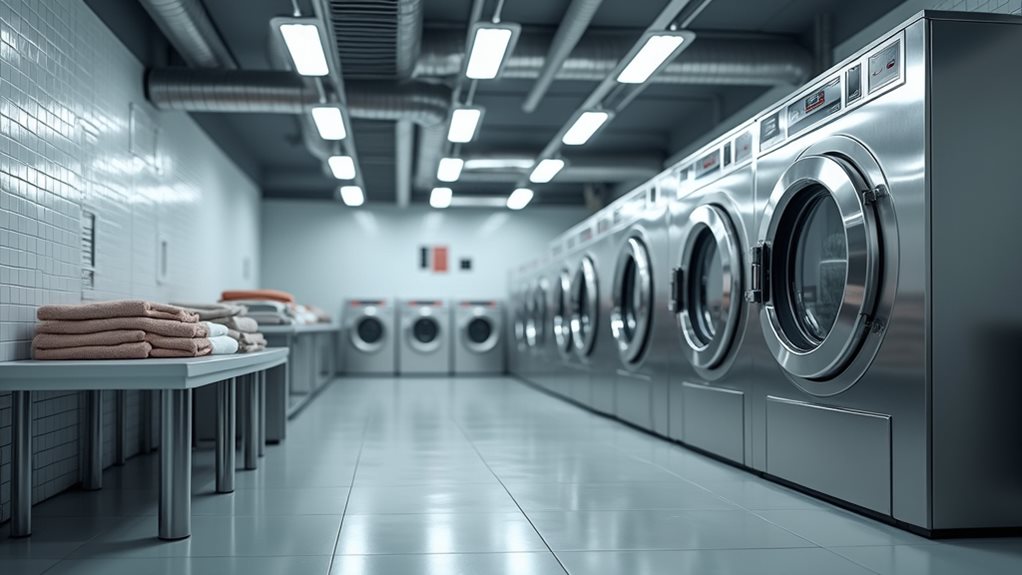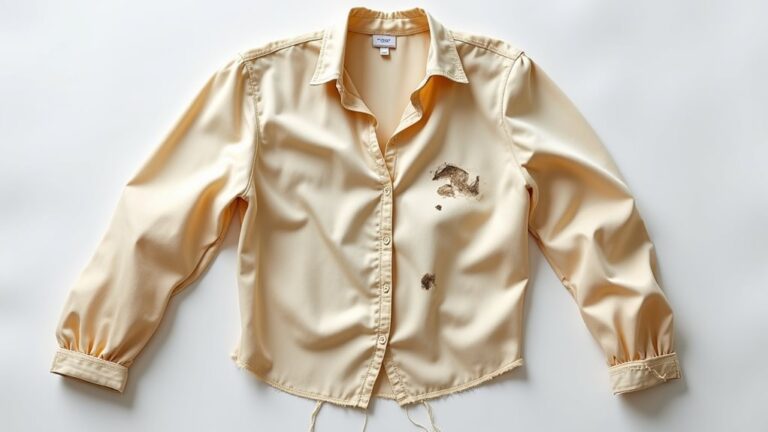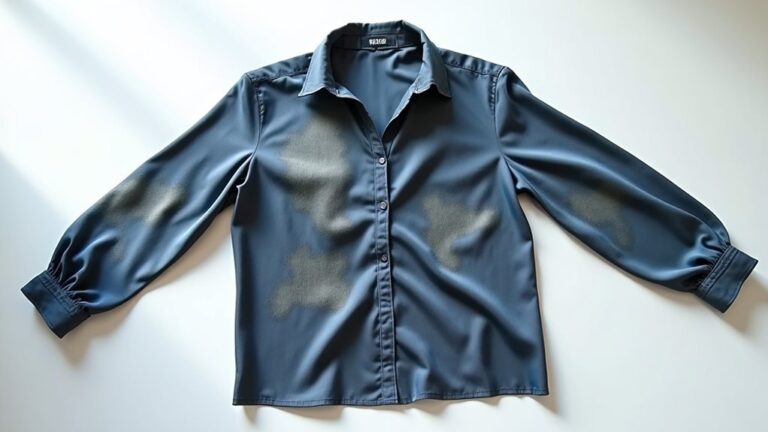Most laundromats don’t actually have dry cleaning machines on-site because these specialized units require trained professionals to handle chemical solvents like perchloroethylene safely – trust me, you wouldn’t want to operate one yourself! Instead, many full-service and premium laundromats cleverly partner with professional dry cleaners, offering convenient drop-off counters where you can handle both your regular washing and delicate garments in one trip, and there’s quite a bit more to discover about these partnerships.
What Are Dry Cleaning Machines and How Do They Work
When I first encountered a dry cleaning machine during a college job at a local cleaner, I’ll admit I was completely baffled by this mysterious contraption that somehow cleaned clothes without water – it seemed like magic, honestly! 😅
These sophisticated machines work by circulating liquid solvents, typically perchloroethylene (or “perc” as we called it), through your delicate fabrics instead of using traditional water and detergent, which means those silk blouses and wool suits that carry the dreaded “dry clean only” label can actually survive the cleaning process without shrinking, fading, or falling apart.
What’s really clever is how dry cleaning machines minimize agitation while using solvents to clean clothes, and modern versions feature closed-loop systems that boost environmental safety by recycling those chemicals efficiently.
The entire process includes garment inspection and tagging, pre-treatment of stains, machine agitation in solvent, and a distillation process that purifies and recycles the cleaning solution before final pressing and finishing.
Types of Laundromats That Offer Dry Cleaning Services
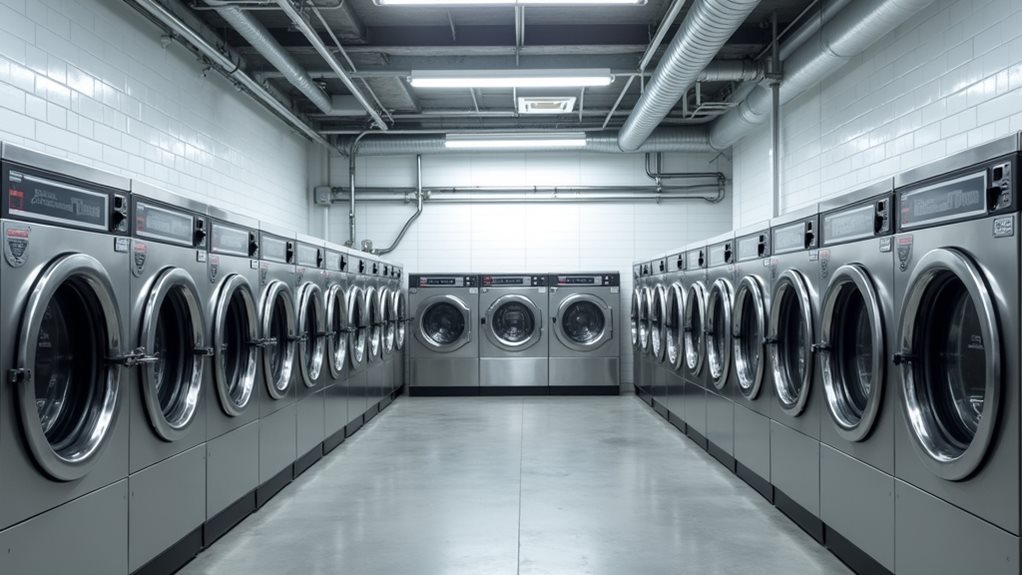
Now that you understand how these fascinating machines actually work, you’re probably wondering where you can actually find them when you need to rescue that expensive blazer from yesterday’s coffee mishap! 😬
Most traditional coin-operated laundromats focus exclusively on washers and dryers, but there’s a growing number of hybrid establishments that have recognized the goldmine opportunity in offering dry cleaning services alongside their standard washing machines.
Here are the main types you’ll encounter:
- Full-service laundromats that partner with specialized dry cleaning companies for thorough garment care
- Premium self-service laundry facilities featuring dedicated drop-off counters with trained staff
- Neighborhood hybrids offering basic alterations and stain removal alongside traditional washing
- Upscale establishments with competitive pricing for dry cleaning that rivals standalone cleaners
These hybrid laundromats particularly cater to essential workers who need convenient access to professional cleaning services for uniforms and work attire that require specialized care.
The Difference Between Traditional Washing and Dry Cleaning Methods

Although both methods clean your clothes, the fundamental difference between traditional washing and dry cleaning lies in what actually touches your garments during the cleaning process, and honestly, understanding this distinction saved me from ruining my favorite wool sweater last winter! 😅
Traditional washing machines at laundromats rely on water, detergent, and mechanical agitation to remove dirt and stains, which works brilliantly for sturdy fabrics like cotton, polyester, and denim that can handle the tumbling action and moisture absorption.
Laundromat washing machines use water and detergent with mechanical action, making them ideal for durable fabrics like cotton and denim.
Dry cleaners use specialized chemical solvents instead of water, creating a gentler approach that’s perfect for delicate garments like silk blouses or cashmere coats.
The dry cleaning process also involves pre-treating stains before immersing clothes in a solvent bath, typically using perchloroethylene or newer eco-friendly alternatives.
While laundromats typically offer high-capacity machines for everyday items, these different cleaning methods serve distinct purposes based on your fabric’s specific needs.
Benefits of Having Dry Cleaning Available at Self-Service Facilities
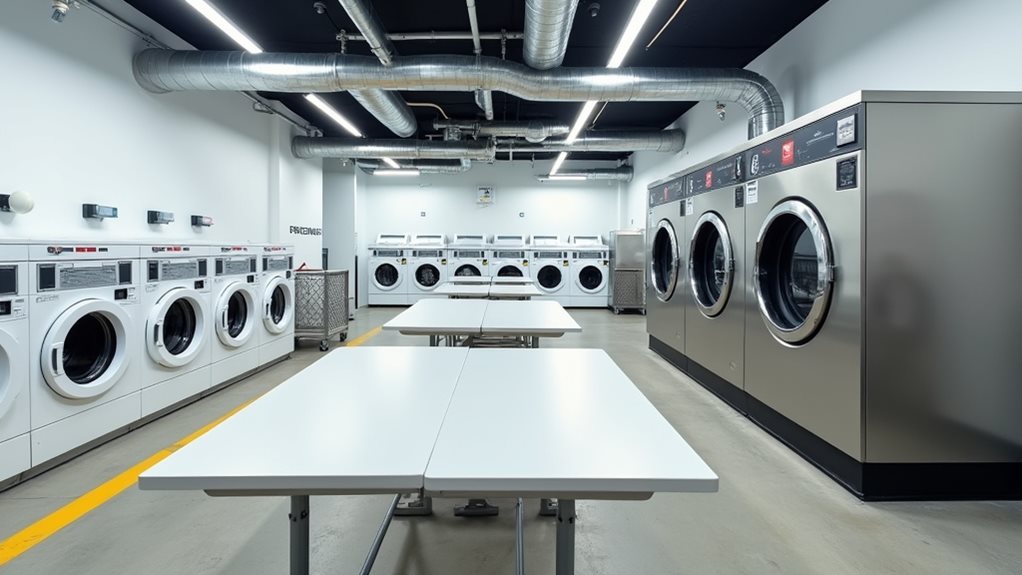
When you’re juggling a mountain of laundry and suddenly realize your favorite blazer needs professional care, having dry cleaning available at your local laundromat becomes a game-changer that saves you from making multiple stops around town.
You’ll find that this convenient setup not just cuts down on your precious weekend time, but it also creates opportunities for more cost-effective garment care since you’re handling all your fabric needs in one efficient trip.
The beauty of this arrangement lies in how it transforms what used to be a tedious chore split across different locations into a streamlined experience where you can tackle everything from your everyday jeans to that delicate silk dress without the hassle of coordinating multiple errands.
Having access to specialized solvents at the same location where you do regular washing means you can properly care for oil-based stains and delicate fabrics that would be damaged by traditional water-based washing methods.
Convenience and Time Savings
Most busy people I know, myself included, have experienced that familiar Sunday evening panic when you realize your work clothes are either sitting in a wrinkled heap or desperately need professional cleaning before Monday morning rolls around.
Finding a laundromat that offers dry cleaning services becomes a game-changer for busy individuals juggling demanding schedules.
Here’s how this convenience can transform your weekly routine:
- One-stop solution – Handle all your laundry needs during a single trip
- Weekend efficiency – Tackle both everyday and delicate garments simultaneously
- Time optimization – Eliminate separate dry cleaner visits throughout the week
- Stress reduction – No more Monday morning wardrobe emergencies 😅
When you can save time by combining these errands, you’re fundamentally buying back precious hours for family, hobbies, or simply catching your breath.
The dry cleaning process uses chemical solvents instead of water to remove stains and dirt from delicate fabrics like wool suits and silk dresses without causing damage that traditional washing might inflict.
Cost-Effective Garment Care
While traditional dry cleaners can drain your wallet faster than a teenager with a credit card, laundromats offering dry cleaning services typically provide the same quality care at considerably lower prices.
You’ll find that these self-service laundromat facilities create competitive pricing structures because they operate with lower overhead costs than standalone establishments.
When you need convenient garment care for delicate fabrics or those pesky “dry clean only” labels, these cost-effective solutions become your financial lifesaver.
I’ve watched countless customers save noteworthy money by choosing laundromat dry cleaning services over traditional options, especially when dealing with seasonal clothing rotations or special occasion garments.
The affordability factor means you won’t hesitate to properly care for your wardrobe, ultimately extending your clothes’ lifespan and maximizing your fashion investment. 💰
Traditional dry cleaning services typically charge between $3 to $15 per garment, with fabric type and garment complexity being major factors in determining the final price.
How to Identify Fabrics That Require Dry Cleaning
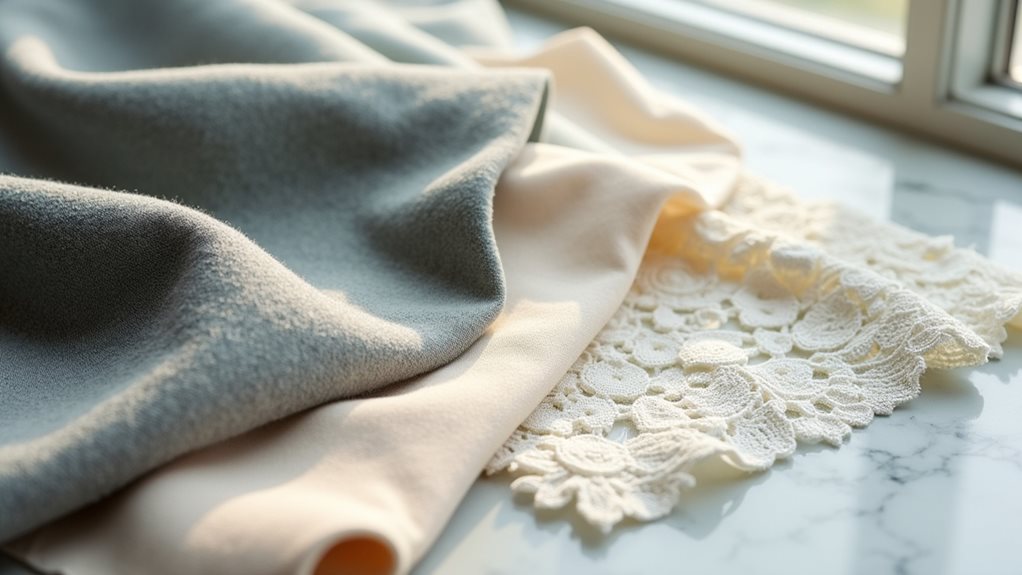
Why do some clothes seem to mock you every time you glance at their care labels, practically daring you to toss them in your washing machine?
Learning to identify fabrics that require dry cleaning can save you from costly wardrobe disasters, and honestly, it’s easier than you might think.
Mastering fabric identification is your wallet’s best friend—and surprisingly simple once you know what to look for.
Here’s how to spot the troublemakers:
- Delicate materials like silk, wool, and cashmere literally can’t handle water’s harsh reality.
- Structured clothing such as blazers and suits need dry cleaning to maintain their professional finish.
- Embellished garments with sequins or beads will lose their sparkle in regular wash cycles.
- Water-repelling fabrics like leather and suede require specialized dry cleaning care.
Items that are prone to shrinking or color bleeding also benefit from professional dry cleaning, as do garments with care labels specifically indicating “dry clean only.”
Trust me, respecting these fabric boundaries will keep your favorite pieces looking amazing longer!
Cost Comparison Between Laundromat Dry Cleaning and Professional Dry Cleaners
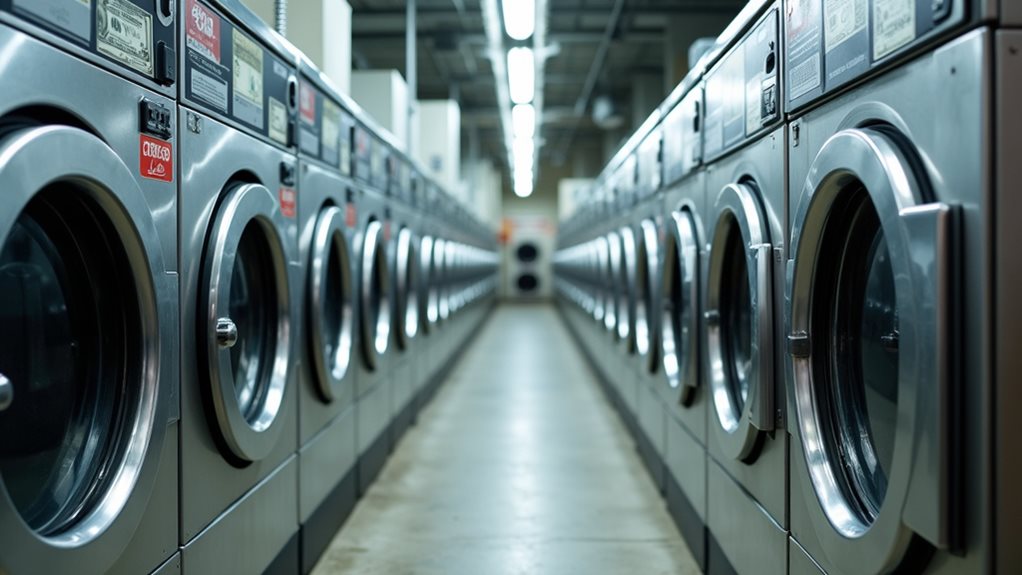
When you’re weighing whether to invest in dry cleaning equipment for your laundromat or stick with traditional washers, you’ll need to take into account the massive upfront costs that can easily reach six figures for professional-grade machines.
The pricing models between these two approaches couldn’t be more different—while you might charge customers $4.25 for a regular wash cycle, professional dry cleaners command $10-30 per garment because they’re covering specialized solvents, training, and equipment maintenance that’ll make your head spin 💸.
Your operating expenses will shift dramatically too, since dry cleaning requires hazardous chemical handling, environmental compliance, and insurance costs that traditional laundromat owners never have to lose sleep over.
Beyond the financial considerations, you’ll also need to factor in the health and safety requirements since traditional dry cleaning uses perchloroethylene (PERC), a toxic chemical that requires specialized ventilation systems and worker protection protocols.
Equipment Investment Costs
- A single dry cleaning machine costs $60,000-$80,000 upfront.
- High-capacity washing machines offer loads at $4.25-$10.50 each.
- Environmental compliance adds thousands in operational costs.
- Maintenance for specialized services requires expert technicians.
- Total startup investments for a full dry cleaning operation typically range from $200,000 to $500,000, requiring business licensing, environmental permits, and specialized chemical systems.
You can see why laundromat owners stick to their proven business model – the math simply doesn’t support such massive investments when their customers primarily need affordable, everyday cleaning solutions.
Service Pricing Models
While you might hope that laundromats could offer dry cleaning at their famously budget-friendly prices, the reality creates a stark contrast that’ll make your wallet feel the difference immediately.
Traditional laundromats charge based on weight, typically $4.25 to $10.50 for loads, making them perfect for everyday fabrics like cotton and polyester.
However, professional dry cleaning services price per garment, ranging from $5 to $15 each, because they’re handling delicate fabrics that require specialized solvents instead of water.
When you’re dealing with silk blouses or wool suits, you’re paying for expertise that protects your investment.
The pricing reflects the reality that different fabrics need different care approaches, and laundromats simply aren’t equipped for those specialized services offered by professional cleaners.
Professional dry cleaners also face higher operational costs due to the need for proper ventilation and safety measures when handling traditional solvents like perchloroethylene, which can pose health risks to workers with prolonged exposure.
Operating Expense Factors
Since most laundromats don’t actually offer dry cleaning services, you’re really comparing two completely different business models with vastly different expense structures that directly impact what you’ll pay.
When I first started researching operating costs for my friend’s business venture, I discovered these eye-opening differences:
- Equipment Investment – Professional dry cleaners invest heavily in specialized machinery and chemical solvents, while laundry services use standard washers and dryers.
- Training Requirements – Dry cleaning demands extensive fabric expertise, whereas laundromats need basic maintenance knowledge.
- Chemical Costs – Specialized service providers face ongoing solvent expenses that traditional laundromats avoid entirely.
- Volume Efficiency – Laundromats process higher customer volumes with faster turnarounds.
These factors explain why professional dry cleaners charge $10-30 per garment while laundromats offer more affordable alternatives.
Operating Dry Cleaning Machines in Self-Service Environments
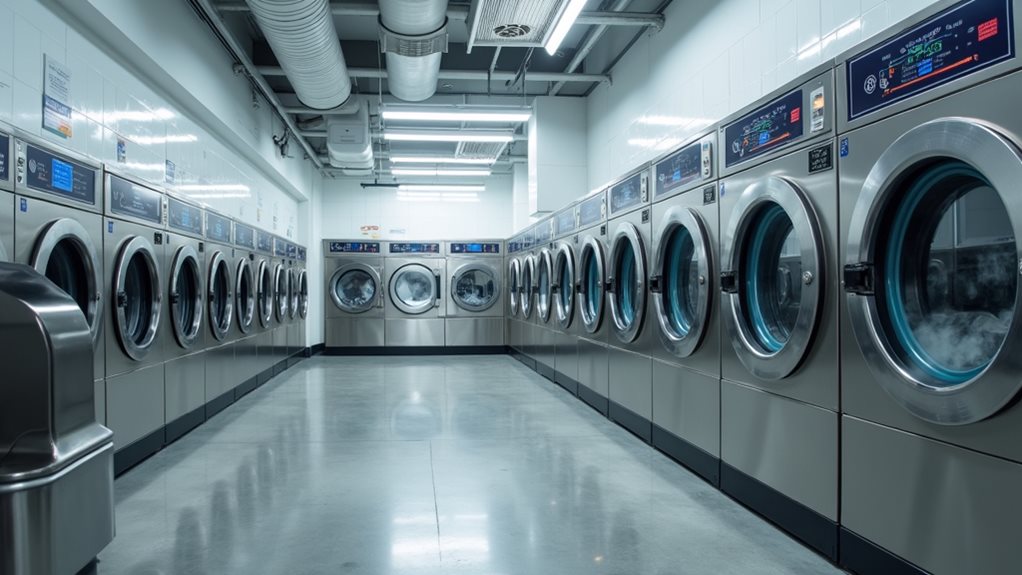
Although the idea of tossing your silk blouse into a machine alongside someone else’s work shirts might sound convenient, operating dry cleaning machines in self-service environments presents challenges that would make even the most patient person want to pull their hair out.
These specialized machines require chemical solvents that aren’t exactly something you’d want your neighbor accidentally spilling on themselves during their 2 AM laundry run. Unlike throwing detergent into a washer, dry cleaning equipment demands trained professionals who understand the intricate processes involved.
That’s why most laundromats stick to offering drop-off services instead, partnering with dedicated dry cleaning establishments to handle your delicate garments safely while keeping their focus on what they do best.

